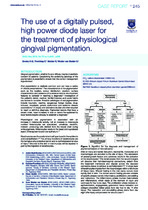| dc.contributor.author | Booley, A-B | |
| dc.contributor.author | Peerbhay, F. | |
| dc.contributor.author | Mulder, R. | |
| dc.contributor.author | Mulder-van Staden, S. | |
| dc.date.accessioned | 2019-10-29T07:53:20Z | |
| dc.date.available | 2019-10-29T07:53:20Z | |
| dc.date.issued | 2018 | |
| dc.identifier.citation | Booley, A-B, Peerbhay, F., Mulder, R., & Mulder-van Staden, S.. (2018). The use of a digitally pulsed, high power diode laser for the treatment of physiological gingival pigmentation. South African Dental Journal , 73(4), 245-248. http://www.scielo.org.za/scielo.php?script=sci_arttext&pid=S0011-85162018000400016&lng=pt&tlng=en. | en_US |
| dc.identifier.issn | 0375-1562 | |
| dc.identifier.uri | http://ref.scielo.org/fsyf8n | |
| dc.identifier.uri | http://hdl.handle.net/10566/5065 | |
| dc.description.abstract | Gingival pigmentation, whether focal or diffuse, may be of aesthetic concern to patients. Establishing the underlying aetiology of the pigmentation is essential to ensure that the correct management is performed.
Oral pigmentation is relatively common and can have a variety of clinical presentations. The characteristics of the pigmentation such as the location, colour, distribution, duration, surface characteristics and presence of cutaneous lesions are important features to consider in reaching a diagnosis. Investigation of the patient's dental, medical, familial histories and social habits are factors to consider. Possible aetiologies of oral pigmentation include traumatic, reactive, exogenous foreign bodies, drug-induced, neoplastic, genetic dysfunction and systemic disease associations. A biopsy and laboratory studies are often required to reach a definitive diagnosis. Pigmented lesions that have a recent onset, have increased in size or cannot be explained by local factors require a biopsy to establish a diagnosis.
Physiological oral pigmentation is associated with an Increase in melanocyte activity, not an increase in melanocyte number. Melanocytes are specialized, unicellular, dendritic, melanin- producing cells derived from the neural crest during embryogenesis. Melanocytes reside in the basal and suprabasal layers of the epidermis and oral epithelium.
Keratinocytes are the predominant cell type found in the epidermis and oral epithelium. The primary functions of keratinocytes are the formation of a protective barrier and re-epithelialization at sites of injury. Wounds to the skin or oral mucosa will be repaired in part by the migration of keratinocytes. | en_US |
| dc.language.iso | en | en_US |
| dc.publisher | The South African Dental Association | en_US |
| dc.subject | Gingival pigmentation | en_US |
| dc.subject | Diode laser | en_US |
| dc.subject | Oral pigmentation | en_US |
| dc.subject | Pigmented lesions | en_US |
| dc.subject | Keratinocytes | en_US |
| dc.title | The use of a digitally pulsed, high power diode laser for the treatment of physiological gingival pigmentation | en_US |
| dc.type | Article | en_US |

